Round The World and other travels
A frequent flyer's collection of trip diaries
Planes, Trains & Automobiles - The Sequel
Black Friday? Not a bit of it!
I managed to get around six hours of solid sleep, occasionally punctuated by dreams. After 3am, it was more a case of slipping in and out of light dozing. The train arrived at Sacramento, the California state capital, at 0515, well over an hour ahead of schedule. I needed to get up to visit the toilet and managed to extricate myself from bed quite easily, no doubt helped by the stationary train and by Bruce guiding my foot onto the first rung of the ladder. I decided that I may as well stay up and took advantage of the long wait at Sacramento to experience a 'first' for me: a shower on board a train. To my surprise, it worked well and was perfectly acceptable.
We broke with the previous day's practice and decided to eat breakfast in the normal dining car, due to the better menu selection available there. The train arrived at Emeryville more or less on time and we transferred onto the busy connecting bus for downtown San Francisco. This short journey provided another 'first' for me, as we used the new Eastern Span section of the Bay Bridge between Oakland and Yerba Buena Island, while demolition activities could be observed on the old bridge, alongside. The new section of the route had only been open since September 2013 and had the distinction of being the world's widest bridge - for the time being, at least.
 Having
then crossed the original Western Span, the bus arrived at the Ferry
Building a little early, despite being late leaving Emeryville.
After collecting our luggage, it was simply a case of crossing the
Embarcadero to reach the final hotel of the trip, the Hyatt Regency.
First impressions were spectacular: the hotel has the largest lobby
atrium in the world and it was suitably, if a little prematurely,
decked out for Christmas. Luckily our room was available, so that it
was possible to drop off our main bags and reorganise our clothing
and smaller bags for the weather and the destination.
Having
then crossed the original Western Span, the bus arrived at the Ferry
Building a little early, despite being late leaving Emeryville.
After collecting our luggage, it was simply a case of crossing the
Embarcadero to reach the final hotel of the trip, the Hyatt Regency.
First impressions were spectacular: the hotel has the largest lobby
atrium in the world and it was suitably, if a little prematurely,
decked out for Christmas. Luckily our room was available, so that it
was possible to drop off our main bags and reorganise our clothing
and smaller bags for the weather and the destination.
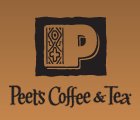
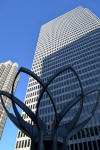 Very
shortly, we set out again into the beautifully sunny morning. I wasn't
even wearing a jacket, on the second-last day of November! This was
the day known in America as 'Black Friday', a name that I found
particularly odd because I have always associated the term with any
Friday which is also the 13th day of the month, and with the
superstitious belief that such a day brings bad luck. In the US,
Black Friday is simply the day after Thanksgiving, traditionally the
first shopping day for Christmas when retailers see an end to
several months of trading at a loss as their businesses - here it
comes - move back into the black. Coincidentally, but appropriately
in hindsight, we decided to support a local Bay Area-based business
and grab some coffee at Peet's.
Very
shortly, we set out again into the beautifully sunny morning. I wasn't
even wearing a jacket, on the second-last day of November! This was
the day known in America as 'Black Friday', a name that I found
particularly odd because I have always associated the term with any
Friday which is also the 13th day of the month, and with the
superstitious belief that such a day brings bad luck. In the US,
Black Friday is simply the day after Thanksgiving, traditionally the
first shopping day for Christmas when retailers see an end to
several months of trading at a loss as their businesses - here it
comes - move back into the black. Coincidentally, but appropriately
in hindsight, we decided to support a local Bay Area-based business
and grab some coffee at Peet's.
Next on the agenda was a return to the nearby section of the Embarcadero and in particular the attractive Ferry Building, the point at which we had arrived in town. Opened in 1898, the Ferry Building was once one of the busiest public transport terminals in the world, but its importance declined with the construction of the Golden Gate and Bay bridges. In the second half of the twentieth century it suffered the further indignity of being almost obscured from view on the city side by the hideous Embarcadero freeway, demolished after suffering extensive damage in the 1989 earthquake. The building was restored to its former glory in 2003 and now serves as a combined ferry terminal, upscale food market and office block. The clock tower, based on the well-known Giralda in Seville, looked particularly fine against the cloudless, blue sky of this gorgeous late-autumn morning.
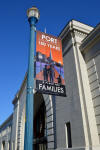 |
 |
 |
 |
 |
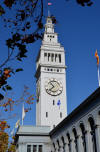 |
 |
 |
 |
 |
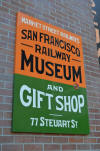
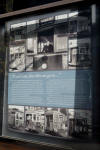
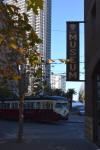
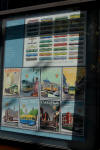 After
having a look around and soaking up some of the atmosphere in the
food market, we paid a quick visit to the nearby San Francisco
Railway Museum. This small but interesting venture has free entry
and covers all rail-based transport in the city, both in the past
and up to the present day. It is run by Market Street Railway, the
not-for-profit, volunteer-dependent group which, alongside the
official city transport undertaking MUNI, was responsible for the
relatively recent introduction of beautifully restored vintage
streetcars on the 'F' line along the Embarcadero and Market Street.
The line runs directly in front of the museum entrance as it crosses
from Steuart Street onto the Embarcadero.
After
having a look around and soaking up some of the atmosphere in the
food market, we paid a quick visit to the nearby San Francisco
Railway Museum. This small but interesting venture has free entry
and covers all rail-based transport in the city, both in the past
and up to the present day. It is run by Market Street Railway, the
not-for-profit, volunteer-dependent group which, alongside the
official city transport undertaking MUNI, was responsible for the
relatively recent introduction of beautifully restored vintage
streetcars on the 'F' line along the Embarcadero and Market Street.
The line runs directly in front of the museum entrance as it crosses
from Steuart Street onto the Embarcadero.
Our next objective, the Rincon Center, was barely half a block away on Mission Street. This multi-purpose complex is based on the original Rincon Annex building, a former US Post Office that has been added to the National Register of Historic Places. The main vestibule features murals depicting the history of California and I thought it had been beautifully preserved.
 |
 |
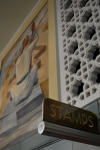 |
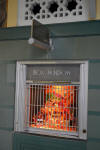 |
 |
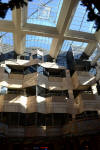 |
 |
 |
 |
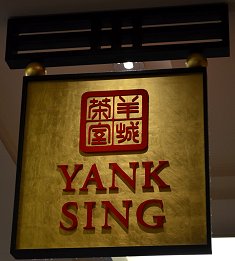
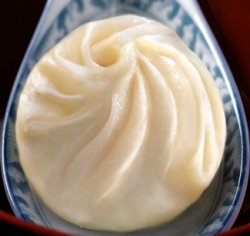 Growing
out of the post office building was a thoroughly modern atrium that
formed the access point to shops, restaurants, offices and
apartments. Our next stop was Yank Sing, an extremely
popular dim sum restaurant that was busier than ever on this day
that was not officially a public holiday but in practice might as
well have been. In accordance with our plan, we had a fabulous
brunch there. They had a somewhat unusual way of doing things:
servers toured the restaurant with food carts (erm, not
Portland-style!) trying to drum up interest in whatever they were
offering. Food would then be served at the table and an appropriate
entry was made on the customer's tab.
Growing
out of the post office building was a thoroughly modern atrium that
formed the access point to shops, restaurants, offices and
apartments. Our next stop was Yank Sing, an extremely
popular dim sum restaurant that was busier than ever on this day
that was not officially a public holiday but in practice might as
well have been. In accordance with our plan, we had a fabulous
brunch there. They had a somewhat unusual way of doing things:
servers toured the restaurant with food carts (erm, not
Portland-style!) trying to drum up interest in whatever they were
offering. Food would then be served at the table and an appropriate
entry was made on the customer's tab.

 After
satisfying our stomachs for hours to come, we set off towards our
next objective, the Castro. It has always intrigued me that certain
areas of towns and cities have managed to acquire the definite
article as part of their names in popular parlance, while others have
absolutely not. San Francisco has the Castro, the Mission and the (best
avoided) Tenderloin, among others, while nobody would ever dream of
adding "the" to Nob Hill, Chinatown or Fisherman's Wharf. I suppose
it's just one of life's little mysteries. There was no mystery
about how to achieve this next objective: after spending part of the
morning in the Railway Museum, the obvious method was by vintage
streetcar along Market Street on the 'F' Line.
After
satisfying our stomachs for hours to come, we set off towards our
next objective, the Castro. It has always intrigued me that certain
areas of towns and cities have managed to acquire the definite
article as part of their names in popular parlance, while others have
absolutely not. San Francisco has the Castro, the Mission and the (best
avoided) Tenderloin, among others, while nobody would ever dream of
adding "the" to Nob Hill, Chinatown or Fisherman's Wharf. I suppose
it's just one of life's little mysteries. There was no mystery
about how to achieve this next objective: after spending part of the
morning in the Railway Museum, the obvious method was by vintage
streetcar along Market Street on the 'F' Line.
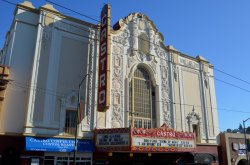 ABOVE: Sing-a-long Sound of Music and The Wizard of Oz? No stereotypes here, then! |
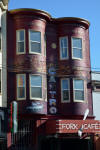 |
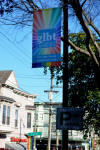 |
 |
 |
The Castro is where Bruce used to live and where I first met him during my round-the-world trip in 2004. Originally known as Little Scandinavia and then morphing into a working-class Irish-immigrant neighbourhood, it has since the 1970s been indelibly linked to San Francisco's substantial gay community. The Castro was also the focal point of the civil rights struggles of the late 20th century, as vividly recalled by the 2008 movie Milk. We visited the thought-provoking GLBT History Museum, the first full-scale, standalone venture of its type in the United States.
Next on the agenda was a walk along 18th Street to the adjacent Mission district, another of San Francisco's 'definite article' neighbourhoods. Strangely, given the area's reasonably central location, this was a first visit for me. The district is so called because it was built on the lands of La Misión de Nuestro Padre San Francisco de Asís, one of the original chain of religious missions in California and the very origin of the city itself. Although uncomfortably aware that the trip was beginning to draw to a close, I thought that strolling along in the glorious sunshine, through a part of town that I had never seen before and that seemed to be stuffed full of archetypal San Francisco architecture, was a perfect way to be spending time at this point.
 |
 |
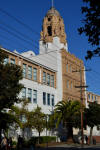 |
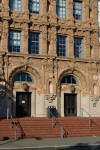 |
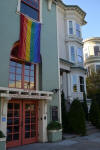 |
 |
 |
 |
 |
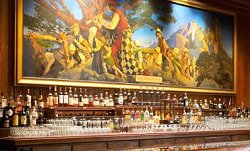 When
we were finally done, we decided to take the MUNI metro back to the
hotel where a rest, and indeed a little siesta, were most definitely
in order. Batteries recharged, we headed out again at 7pm. Our first
stop was for cocktails at the Pied Piper Bar of the Palace Hotel,
part of Starwood's high-end Luxury Collection. Since the summer of
2013, the bar had once again been home to a stunning painting
depicting the Pied Piper of Hamelin story, following reversal of an
earlier decision that had seen the artwork removed for sale. What
seemed strange was that, in these exclusive surroundings, the bar
was heaving with rather noisy customers. Bruce confirmed my own
suspicions by pointing out that they were "definitely not the usual
crowd".
When
we were finally done, we decided to take the MUNI metro back to the
hotel where a rest, and indeed a little siesta, were most definitely
in order. Batteries recharged, we headed out again at 7pm. Our first
stop was for cocktails at the Pied Piper Bar of the Palace Hotel,
part of Starwood's high-end Luxury Collection. Since the summer of
2013, the bar had once again been home to a stunning painting
depicting the Pied Piper of Hamelin story, following reversal of an
earlier decision that had seen the artwork removed for sale. What
seemed strange was that, in these exclusive surroundings, the bar
was heaving with rather noisy customers. Bruce confirmed my own
suspicions by pointing out that they were "definitely not the usual
crowd".
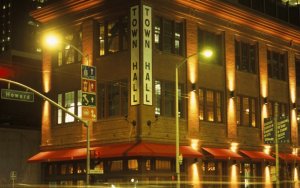
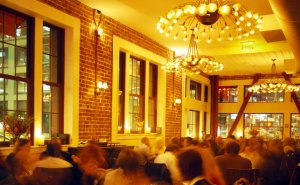 This
was followed by a fabulous dinner at the extremely popular Town Hall
restaurant on Howard Street, where the food and service were
outstanding and the atmosphere was buzzing. It was an easy walk back
to the Hyatt Regency afterwards and as I drifted off to sleep that
night, I could hardly believe how much we had managed to pack into
this one day that had started so long ago, on a train awaiting its
scheduled departure time at Sacramento station.
This
was followed by a fabulous dinner at the extremely popular Town Hall
restaurant on Howard Street, where the food and service were
outstanding and the atmosphere was buzzing. It was an easy walk back
to the Hyatt Regency afterwards and as I drifted off to sleep that
night, I could hardly believe how much we had managed to pack into
this one day that had started so long ago, on a train awaiting its
scheduled departure time at Sacramento station.